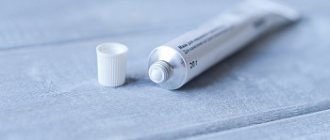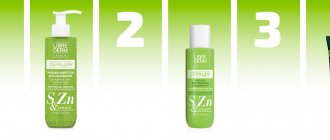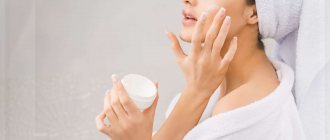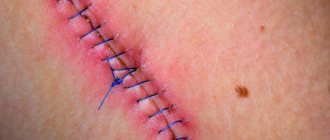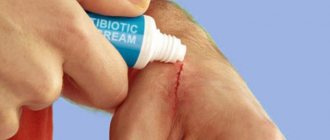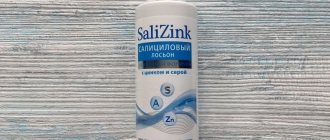April 5, 2020
When considering what ointments are used for dermatitis, it is worth saying right away that they are divided into two large groups: hormonal and non-hormonal. They differ not only in composition, but also in the degree of effectiveness and safety.
An ointment is considered the best for dermatitis on the skin of a particular patient if it meets a number of requirements:
- effectively relieves burning and itching;
- relieves acute and chronic inflammatory processes;
- moisturizes the skin;
- reduces the severity of pain;
- prevents the penetration of viruses, fungi and bacteria into the foci of inflammation (this is evidenced by the absence of secondary attached infections).
What non-hormonal ointments can treat dermatitis?
Non-hormonal ointments are considered safer because they have a relatively natural composition. This allows you to use the external product for a long time without any harm to health.
It is non-hormonal ointments that are considered the best for atopic dermatitis in a child. In adults, in most cases, at the beginning of treatment, doctors also try to prescribe just such ointments. Based on their operating principle, they are divided into several groups:
- Antiseptic. The action is aimed at disinfecting the skin and preventing the penetration of bacteria through the resulting ulcers.
- Anti-inflammatory. Aimed at relieving itching and irritation, eliminating inflammatory processes.
- Moisturizing. Indirectly promote healing by restoring the water balance of the skin.
- Regenerating. Their main effect is to stimulate healing processes by activating the natural regeneration of the skin.
Since products with one main substance can relieve only one symptom, doctors often prescribe combination ointments. Due to several active components, they can have not one, but several effects. Examples of non-hormonal drugs that claim to be the best ointment for dermatitis:
- Bepanten,
- Panthenol,
- Zinc ointment,
- Radevit,
- We see
- Levosin,
- Fenistil,
- Topicrem.
Among the advantages of non-hormonal ointments, the minimum of side effects is of particular importance. Most of them are approved for use in children, pregnant and lactating women.
The main disadvantage of non-hormonal ointments is often their lack of effectiveness. Because of this, treatment may take several weeks, a month or even longer. In this case, the course cannot be interrupted, otherwise the previous therapy may be ineffective. As a result, the doctor still has to prescribe stronger hormonal drugs.
When choosing which ointment is best for dermatitis, you cannot ignore other disadvantages of non-hormonal ointments:
- may cause allergies in people prone to allergic reactions;
- They do not show their effect in all types of dermatitis, more often in contact and allergic ones.
That is, with long-term treatment, the ointment causes allergies, but may not give the desired effect.
Atopic dermatitis: ointments and creams for children and adults
Atopic dermatitis occurs mainly in childhood, so doctors try to prescribe predominantly non-hormonal drugs to treat it. However, if the rash affects large areas of the body and is accompanied by severe skin itching and pain, a dermatologist may recommend a hormonal cream for atopic dermatitis for children. These may be drugs based on hydrocortisone 17-n-butyrate, alklometasone, methylprednisolone aceponate. In addition to glucocorticosteroids, during the acute phase of the disease, antimicrobial and antifungal agents are prescribed for external use: they prevent the development of pathogenic flora that can get into areas of scratching. It is also important to use local preparations that promote the resorption of infiltrate and are made on the basis of naphthalan, birch tar, sulfur and ichthyol.
When remission of the disease occurs, prophylactic use of products with polyunsaturated fatty acids, plant extracts (oak bark, string, chamomile), vitamins E and A is recommended.
Hormonal ointments
When there is no positive dynamics from the use of non-hormonal ointments, specialists resort to hormonal drugs. Their main components are glucocorticosteroids - hormones that are produced by the adrenal glands in the human body. The mechanism of action of such drugs is based on the effect on the metabolism of proteins and carbohydrates. Hormonal ointments restore the level of cortisone, with a deficiency of which the body becomes unable to cope with inflammatory processes.
Depending on the degree of impact on the skin, hormonal ointments are divided into several categories:
- weak,
- average,
- strong,
- very strong.
The latter are used only for the most severe forms of dermatitis, so they are never prescribed first. Examples of hormonal ointments:
- Hydrocortisone,
- Celestoderm,
- Akriderm,
- Advantan,
- Elokom,
- Dermovate,
- Fucicort.
The main disadvantages of hormonal ointments in the treatment of dermatitis:
- Addiction. The main disadvantage is that over time the ointment ceases to be effective for treating a particular patient. The same active components of hormonal ointments are addictive.
- Side effects. Due to their hormonal nature, such ointments have many unpleasant side effects. They appear when used incorrectly or for too long. In severe cases, skin atrophy and even adrenal insufficiency may develop.
- Presence of withdrawal syndrome. As in the case of non-hormonal ointments, when using hormonal ointments, you cannot interrupt the course and skip application. The withdrawal syndrome manifests itself especially strongly when abruptly stopping a hormonal drug. This means that symptoms of dermatitis may suddenly return. For this reason, hormonal drugs are discontinued gradually, reducing the dose and number of applications.
Hormonal products can claim to be the best ointments for dermatitis, but only in terms of effectiveness. Yes, they help cope with the symptoms of the disease faster than non-hormonal ones. But at the same time, they can have a short-term effect, require very strict adherence to the treatment regimen, have side effects and a large list of contraindications, which includes:
- venereal diseases;
- tuberculosis;
- pregnancy and lactation;
- herpes;
- bacterial or fungal skin lesions.
Choosing a cream for dermatitis on the face and body, depending on the type of disease
Dermatitis is divided into the following types:
- Atopic.
- Allergic.
- Seborrheic.
- Contact.
- Diaper.
These types of diseases have different symptoms and causes of occurrence. Therefore, there is no universal remedy for dermatitis that would be equally effective in treating all types of this disease. In each specific case, the dermatologist prescribes the drug to the patient individually.
What ointment to use
As can be seen from the review of ointments for dermatitis, both hormonal and non-hormonal agents cannot be called ideal for treating such a disease. The PsorMak clinic offers both an effective and safe ointment as an alternative. It was created according to its own recipe and has shown its effectiveness for more than 25 years.
The ointment contains no hormones. Instead, there are only natural ingredients that make the ointment safe for children, pregnant and lactating women. The ointment does not cause side effects, does not lead to allergies or aggravation of symptoms.
In addition, we take a comprehensive approach to the treatment of the disease, resorting to comprehensive work with the patient through psychotherapy, acupuncture and hirudotherapy.
We also develop an individual diet for patients. This approach allows us to achieve stable remission for up to 6 years, which is confirmed by reviews and treatment results from our patients. April 5, 2020
Author of the article: dermatologist Mak Vladimir Fedorovich
Seborrheic dermatitis cream
Seborrheic dermatitis usually affects areas of the body that have a large number of sebaceous glands. One of the most unpleasant signs of this type of disease is that it is often localized in exposed areas of the body. This causes a person not only physical, but also psychological discomfort. Therefore, it is very important to pay special attention to choosing a suitable cream for seborrheic dermatitis on the face (especially in the nasolabial triangle), scalp, neck and other affected areas.
The cause of seborrheic dermatitis is infection of the skin by yeast-like fungi Malassezia, so external antimycotics (antifungal drugs) are prescribed to combat the disease. For treatment, external agents based on ketoconazole, fluconazole, and clotrimazole are used. Another task, in addition to normalizing the skin microflora, is to ensure rapid exfoliation of scales and normalization of sebum (sebum) production.
Cream for diaper dermatitis
Diaper dermatitis is a common problem occurring in infancy. It appears as a result of non-compliance with hygiene rules, insufficient removal of excrement residues from the skin in the anogenital area of the baby, irrational use and rare changes of diapers, and excessive sweating of the baby. This type of disease can affect not only children, but also adults who are forced to wear diapers - the elderly and bedridden patients.
To reduce the symptoms of this type of disease, non-hormonal children's remedies for dermatitis are usually prescribed - for example, with zinc, panthenol, and plant extracts. To prevent the appearance of diaper dermatitis, you can use La-Cri diaper cream. It contains zinc oxide, panthenol, shea and jojoba butters, beeswax and licorice extract.
If an infection joins the rash and inflammation begins, antimycotics and antibiotics are prescribed.
Allergic dermatitis cream
This form of the disease occurs as a result of human contact with an allergen - chemical, food, drug, etc. The disease is characterized by dry and itchy skin, the appearance of flaky, reddened areas, and the formation of papules and blisters. Most often, the rashes are localized on the hands and face.
Treatment involves stopping contact with the allergen and using antihistamines. As for the choice of cream for dermatitis on the hands and face, it depends on the intensity of the symptoms, age and general health of the patient. For mild forms of the disease, remedies based on string, chamomile, violet, menthol, and ichthyol are prescribed. The use of calcineurin inhibitors may also be recommended. If we are talking about a severe form of allergic dermatitis, the use of methylprednisolone aceponate, hydrocortisone acetate, betamethasone dipropionate may be required.
Cream for dermatitis during pregnancy
Dermatitis in pregnant women is quite common. Even if a woman has never suffered from this disease before, it may first appear during pregnancy. One of the reasons for its appearance during this period is a change in the hormonal background of the expectant mother and a decrease in the defenses of her body.
In most cases, the disease goes away on its own after the birth of the child. But this does not mean that you just need to wait for the body to heal itself, because during pregnancy the disease can cause serious physical and emotional discomfort to a woman and make her irritable. In addition, if an infection gets into the scratching area, there is a real danger of inflammation and suppuration of the skin.
Choosing a remedy for the treatment of dermatitis in pregnant women is a serious task, which only a qualified doctor can cope with. Therefore, under no circumstances use drugs that you are not sure of, and do not follow unverified advice and recommendations from neighbors and friends. Trust a professional in this matter, because an incorrectly selected product can cause harm not only to you, but also to the child.
Hormonal creams for dermatitis are prescribed to pregnant women extremely rarely - only in cases where the benefits of their use outweigh the potential harm. If there is no other option, then the doctor must assess the possible risks and prescribe a glucocorticosteroid drug with a minimum dose of hormones.
If possible, instead of corticosteroid medications during pregnancy, it is recommended to use moisturizing and nourishing products containing natural ingredients - vitamins, zinc, plant extracts and oils.
Clinical researches
La-Cri creams for sensitive skin and La-Cri cream for dry skin are recommended by the St. Petersburg branch of the Union of Pediatricians of Russia.
The conducted clinical study proves the high efficiency, safety and tolerability of products for daily skin care of children with mild and moderate forms of atopic dermatitis and during remission, accompanied by a decrease in the quality of life of patients. As a result of therapy, a decrease in the activity of the inflammatory process, a decrease in dryness, itching and flaking was noted.
Sources:
- Tulchinskaya, V.D. Nursing assistance to children / V.D. Tulchinskaya. — Moscow: Russian State University for the Humanities, 2016.
- Andropova T.V., Gudina M.V., Odintsova I.N., Hygiene of children and adolescents, Siberian State Medical University Publishing House, 2022.
- Reken Martin, Schaller Martin, Sattler Elke, Burgdorf Walter, Atlas of Dermatology, MEDpress-inform, 2022.
Photos of dermatitis
Photo album on the diseaseLa-Cri is your assistant in the prevention of dermatitis
La-Cri's non-hormonal products, made from natural, safe ingredients, are excellent for accelerating recovery and preventing this disease. For example, there are many positive reviews about the use of La Cree cream for dermatitis. The active components included in the La-Cri cream for dry skin provide delicate care for damaged skin:
- Natural hypoallergenic oils (wheat germ, jojoba and shea) provide skin nutrition, combat dryness and normalize water-lipid balance.
- Plant extracts (licorice and string) help cope with itching, redness and flaking.
- Beeswax perfectly softens and nourishes the skin.

